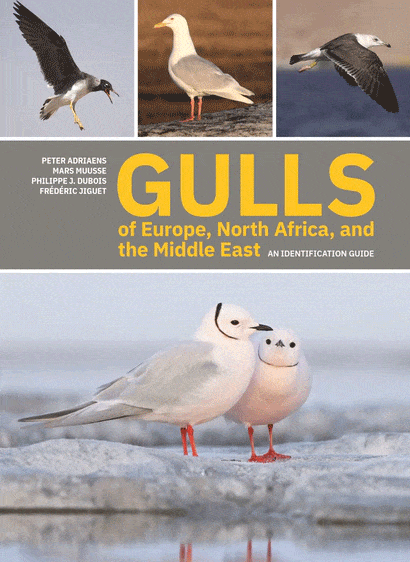Gulls of Europe, North Africa, and the Middle East
| Peter Adriaens, Mars Muusse, Philippe J Dubois & Frédéric Jiguet | Princeton University Press | 2021 | Paperback | 320 Pages | 1400 Colour Photographs | 45 Distribution Maps | ISBN: 9780691222837 | £24.99p |

The Publisher’s View:
Gulls of Europe, North Africa, and the Middle East offers the most up-to-date guide for gull identification in Europe and beyond. With a direct and visual approach, and an exhaustive abundance of beautiful colour photographs, this book provides thorough accounts of the 45 species of gulls found in the Western Palearctic. The guide compares similar taxa and addresses the complexities of identifying hybrids. Sections explore gull watching, migration, aberrant birds, sonograms, and population dynamics. Detailed maps for each species are included. Gulls of Europe, North Africa, and the Middle East will be the standard work for identifying these birds for some time to come.
– Richly illustrated with nearly 1400 colour photographs
– Thorough accounts of the 45 species of gulls found in the Western Palearctic
– Up-to-date information for easy and accurate identification of all taxa as well as hybrids
The Authors: Peter Adriaens is an ecologist who has traveled widely to study and photograph gulls, including gull and tern colonies in Belgium and the Netherlands. Mars Muusse is a Dutch birder specializing in gulls and the founder of the gull identification website Gull Research Organization. Philippe J. Dubois is an ecologist, author, and editorial director of the journal Ornithos. Frédéric Jiguet is a conservation biologist at the National Museum of Natural History in Paris and director of the Center for Research in Biology and Bird Populations. His books include Birds of Europe, North Africa, and the Middle East (Princeton).
Fatbirder View:
There are birders who love gulls and rejoice in their difficult ID; there are birders who hate gulls for the very same reason. Then there are most of us, don’t hate them but find them soooo hard to get to grips with. For us there are two sorts of gulls; the ones with black heads, and the other lot. In most places around the world you don’t have to get to know very many as they tend to be spread across the globes so that only a handful are common wherever your neck of the woods, or more likely your wetland or landfill site, is. In the UK there are six if you count the almost completely pelagic kittiwake. In some places, like New Zealand there are only a couple.
However, gulls a long-lived, intelligent and adaptable birds. Sometimes they stray way off their natural range, sometimes they get a toehold and start to colonise and, like most birds some wander. When they do its often onto territory where there are similar species, and there’s the rub. It’s no good me working hard to distinguish between Herring Gulls and Lesser Black-backs… in amongst them there may be Yellow-legged or even Caspian Gulls. I cannot rely on all those black-headed gulls being, well Black-headed Gulls, as a few Bonaparte’s stray, some Little Gulls may fly by the cliffs, and Med Gulls are colonising the southeast!
I now have choices. Do I rely on clever birders to point out these waifs and strays? Do I pretend they are ‘just gulls’ so need no firmer appellation? Or do I try to get to grips with their subtle differences.
To date, I’ve not firmly decided, mostly relying on others, or easy to spot aberrations, although I have tried to get to grips with the subtle colour variations between Yellow-legged and our own Herring Gulls. Mind you, there is a place I can go and throw out bread and almost guaranteed a Med gull will be amongst the mix nicely showing a complete lack of black wing tip.
Then along comes this excellent and easy to paw over book. It’s good enough to make me think I do stand a chance at getting better. I’m definitely going to give it a go and have it in one hand while I scan through some local gull flocks. I’m ready to try and learn the key ID features of the adults at least.
Despite how very clear the text and how wonderful the illustrations, I’m still not ready to tackle the brown jobs… all those juveniles. The first four years they will remain lost to me.
Fatbirder
